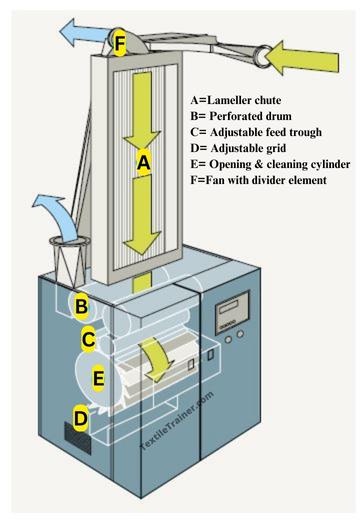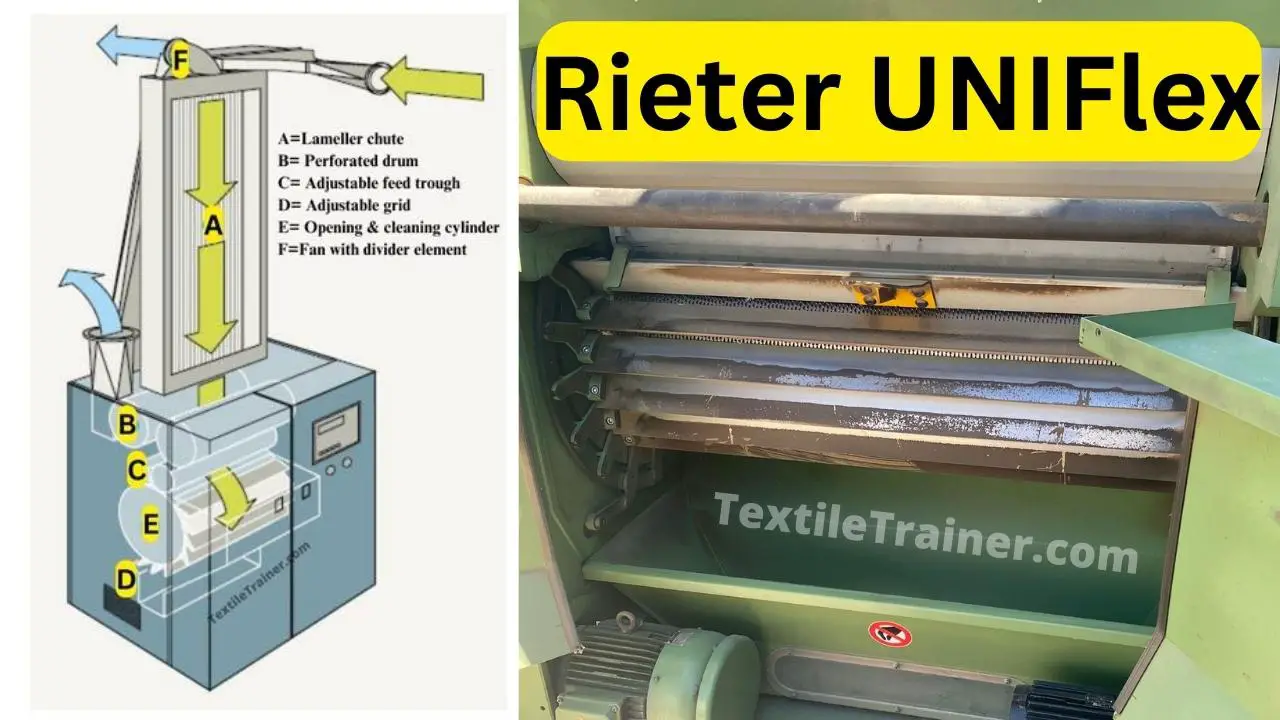Introduction:
The blow room is a crucial first step in the textile manufacturing process when raw fibers are converted into yarn. The Rieter Uniflex machine, which has gained widespread recognition and acclaim in the industry, is one of the key components of a blow room. A state-of-the-art system, the Rieter Uniflex guarantees high-quality yarn production by optimizing fiber opening, cleaning, and blending. To create a homogeneous fiber blend, the blow room process combines different types of fibers efficiently to open, clean, and mix them. Through the provision of advanced technological solutions that enhance productivity, fiber quality, and operational efficiency, Rieter Uniflex plays a pivotal role in achieving this goal.
Working Principle of Rieter Uniflex:

A fan collects the micro tufts by means of suction from the previous machine and a revolving component discharges them into a filing chute (A) by means of a revolving component. The back partition of the chute comprises of specific aluminum lamellae with slot-openings over which the compressed air can discharge (first dedusting step). This results in a very consistent batting laydown, both longitudinally and transversely. Based on the production and fiber nature, the variable chute depth determines the lap weight necessary. A perforated drum (B) (second dedusting step) and a plain drum advance the chute. The fine cleaner is armed with spontaneous lap intake. Therefore, no manual intervention is required when initiation is performed. Depending on the material to be processed, the displacement between the feed roll (C) and opening cylinder (E) is adjusted by the program design. Therefore, the feed trough supplies material to the opening cylinder. A wide range of opening cylinders are available, depending on the material’s requirements. The spinner can adjust the opening cylinder’s revolution speed based on his purposes and raw material by using VARIOset. Using carding fragments and knives, a grid bar (D) creates the cleaning surface and removes impurities. Carding fragments on the knives increase the amount of opening and cleaning. Using VARIOset, the operator can set the knives on the grid according to his purposes and raw materials.
Conclusion:
As part of the textile manufacturing process, the Rieter Uniflex is an advanced and efficient machine. A number of innovative features ensure consistent and high-quality fiber processing, including precise batting laydown, dedusting steps, and adjustable components. It promotes sustainable manufacturing practices by handling various fiber types and reducing energy consumption. Moreover, its automated operation and easy adjustments make it a user-friendly choice for textile manufacturers seeking productivity and operational excellence. Rieter Uniflex is an indispensable tool for producing top-notch yarns while meeting the demands of modern textile production.
References:
- Chowdhury, M. F. (2016). Manual of Short Staple Spinning. Dhaka: Granthanir Prokashoni.
- Corbman, D. P. (1983). Textiles Fiber to Fabric. NewYork: Mary McGarry.
- Hossain, M. S. (2014). Introduction to Textile Engineering. Dhka: Books Fair Publications.
- Kadolph, S. J. (2006). Textiles. New Delhi: Dorling Kindersley India Pvt. Ltd.
- Rieter Manual for Spinning, Volume-II







3 thoughts on “Working Principle of Rieter UNIFlex for Unparalleled Production in Blow Room”